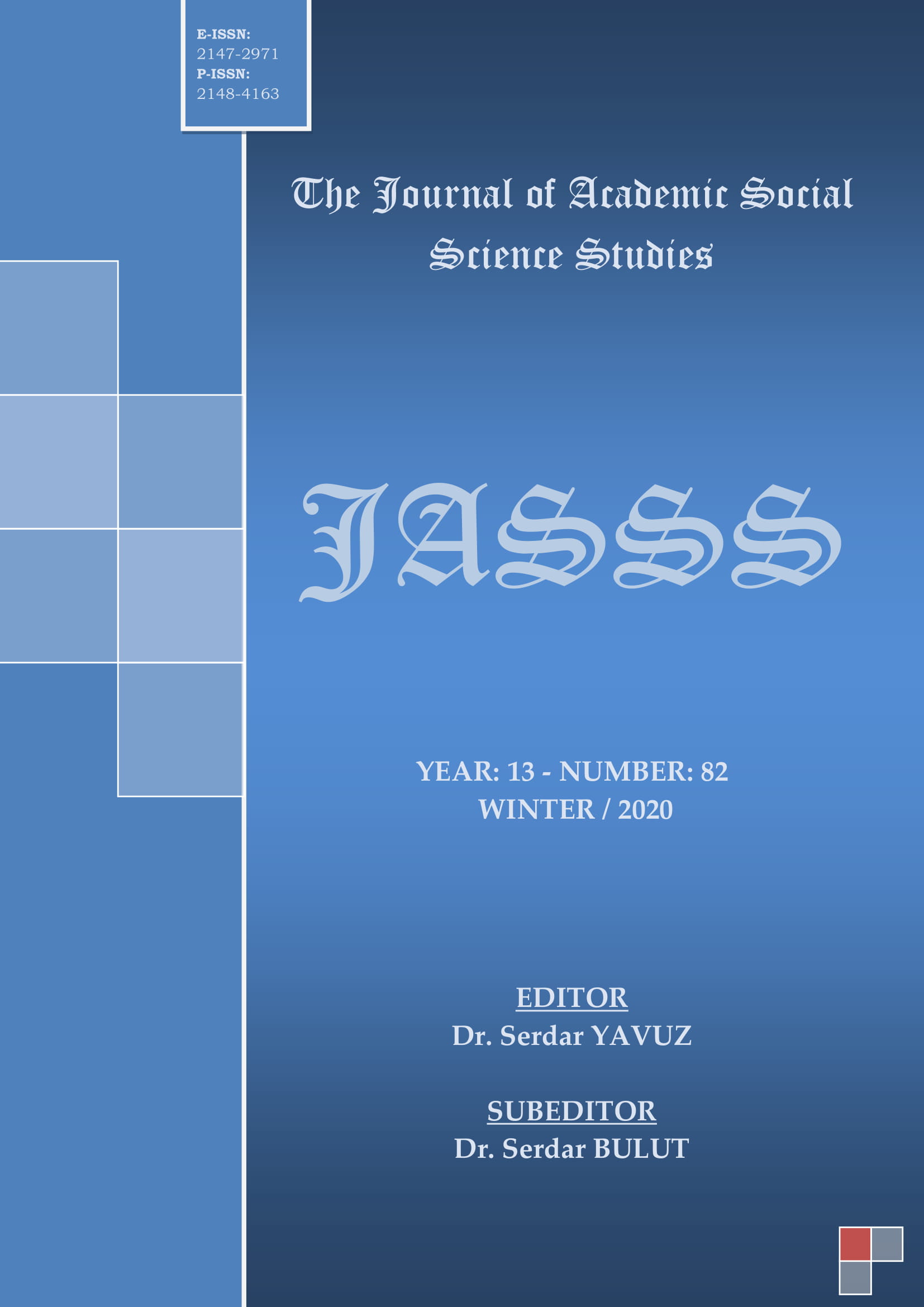NÜFUS DEFTERLERİNE GÖRE KARAHİSAR-I SAHİB (AFYONKARAHİSAR) KAZASINDA GAYRİMÜSLİM NÜFUSUN NİCEL VE NİTEL ÖZELLİKLERİ (1835-1841)
Author :
Abstract
Osmanlı Devleti’nde toprak yazımı vesilesi olmadan, sadece nüfusun tespitine yönelik ilk nüfus sayımı 1831’de yapılmıştır. Temel amacı ülkenin asker ve vergi potansiyelini tespit etmek olan bu sayımda sadece Müslim ve gayrimüslim erkek nüfus dikkate alınmıştır. Bu bağlamda Yeniçeri Ocağı’nın kaldırılması neticesinde kurulan Asakir-i Mansure-i Muhammediyye adlı yeni askeri teşkilata asker tedarik etmek için Müslüman nüfusun; cizye vergisi mükellefi olarak da gayrimüslim nüfusun tespitine çalışılmıştır. Bu sayımdan sonra ülkede düzenli olarak nüfus yoklamaları şeklinde yeni sayımlar yapılmış, bu sayımların kayıt edildiği defterler merkeze gönderilmiştir. Genel olarak Nüfus Defterleri olarak isimlendirilen bu defterler, ait oldukları mahallin demografik, sosyal ve kültürel yapısı bakımından son derece önemli bilgiler içermektedir. Bu çalışmada, 1835-1841 yılları itibarıyla Karahisar-ı Sahib kazasında ikamet eden gayrimüslim nüfusun kayıtlarını içeren Reaya Nüfus Defterleri dikkate alınarak, bu nüfusun nicel ve nitel hususiyetleri hakkında bilgiler verilmeye çalışılmıştır. Bu çerçevede, öncelikle kazada ikamet eden gayrimüslim nüfusun miktarı tespit edilerek, bu nüfusun mahallelere göre dağılımı, nüfus hareketleri ve doğum-ölüm vakaları incelenmeye çalışılmıştır. Daha sonra, cizye vergisi mükellefi olan nüfusun miktar ve niteliği tespit edilerek bunların gelir durumları ile ilgili değerlendirmeler yapılmıştır. Akabinde de gayrimüslimler tarafından kullanılan şahıs isimleri, lakaplar ve sülale isimleri ile bunların yaş özellikleri, fiziki durumları, icra ettikleri meslekler tablo ve grafikler eşliğinde açıklanmaya çalışılmıştır.
Keywords
Abstract
In the Ottoman Empire, the first population census only for the purpose of determining population without the excuse of land records was carried out in 1831. In the census the major aim of which was to detect the soldier and tax potential of the country, only Muslim and non-muslim men were taken into consideration. In this sense, it was attempted to determine the Muslim population in order to provide soldiers for the new military organization called “Asakir-i Mansure-i Muhammediyye” established as a result of the abolition of the Janissaries and the non-muslim population as the taxpayers of jizya. Following this, new censuses were conducted regularly as population counts in the country, and the books in which these censuses were recorded were sent to the centre. These books generally named as “Population Books” included crucial information in terms of demographic, social, and cultural structure of the areas where they belong. In this research, information about the quantitative and qualitative characteristics of non-muslim population was tried to be given by considering the Reaya Population Books including the records of the this population inhabiting in Karahisar-ı Sahib district by years 1835-1840. Within this scope, the study tried to investigate this population’s distribution by neighbourhoods, population movements, and birth-death events by firstly detecting the number of the non-muslim population inhabiting in the district. Then by detecting the number and characteristics of the population that was the taxpayer of jizya, evaluations were carried out related to the income status of this population. Subsequently, the personal names, nicknames, and family names used by non-muslims and their age characteristics, physical conditions, and professions were tried to be explained with tables and graphics.
Keywords
- Akbayar, N. (1985). Tanzimat’tan Sonra Osmanlı Devleti Nüfusu. Tanzimat’tan Cumhuriyet'e Türkiye Ansiklopedisi (C. 5, s. 1238-1246) İçinde. İstanbul: İletişim Yayınları.
- Atabek, Ö. F. (1997). Afyon (Vilayeti) Tarihçesi. (Yay. haz: Akkoyun, T.). Afyon: Afyon Kocatepe Üniversitesi Yayınları.
- Aydın, M. (1990). Sultan II. Mahmud Döneminde Yapılan Nüfûs Tahrirleri. Sultan II. Mahmud veReformları Semineri 28-30 Haziran 1989 Bildirilerinden Ayrı Basım. (s. 81-106) İçinde. İstanbul: Edebiyat Fakültesi Basımevi.
- Barkan, Ö. L. (1940-41). Türkiye'de İmparatorluk Devirlerinin Büyük Nüfus ve Arazi Tahrirleri veHakana Mahsus İstatistik Defterleri. İstanbul Üniversitesi İktisat Fakültesi Mecmuası, C. 2: 214-247.Bilgin, S.; Birinci, A. M.; Çakıcı, M. ve Demircioğlu, S. (2010). Trabzon Nüfus Kütüğü (1834). İstanbul: Düzey Matbaacılık.
- Bulduk, Ü. (2013). XVI. Asırda Karahisar-ı Sahib (Afyonkarahisar) Sancağı. Ankara: Türk Tarih Kurumu Yayınları.
- Çimen, A. (2012). Sayım, Kayıt Düzeni ve Teşkilatlanma Açısından Osmanlı'da Nüfus Hizmetleri. Gazi Üniversitesi İktisadi ve İdari Bilimler Fakültesi Dergisi, C/S. 14 (3): 183-216.
- Darkot, B. (1993). Karahisar, İslam Ansiklopedisi (C. 6, s. 276-284) İçinde. İstanbul: Milli Eğitim BakanlığıEmecen, F. (1988). Afyonkarahisar, İslam Ansiklopedisi (C. I, s. 443-446) İçinde. İstanbul: Türkiye DiyanetVakfı Yayınları.Ercan, Y. (2001). Osmanlı Yönetiminde Gayrimüslimler. Ankara: Turhan Kitabevi Yayınları.
- Güneş, M. (2003). XVIII. Yüzyılın İkinci Yarısında Karahisar-ı Sahib Sancağı, Yayımlanmamış Doktora Tezi, Gazi Üniversitesi Sosyal Bilimler Enstitüsü, Ankara.
- Güneş, M. (2014). Osmanlı Dönemi Nüfus Sayımları ve Bu Sayımları İçeren Kayıtların Tahlili. Akademik Bakış, C/S. 8 (15): 221-240.
- İlgar, Y. (2014). Afyonkarahisar Ermenileri Üzerine Bir Deneme. Yeni Türkiye, C. 60: 1-21.
- İnalcık, H. (1993). Cizye, İslam Ansiklopedisi (C. 8, s. 45-48) İçinde. İstanbul: Türkiye Diyanet VakfıKaral, E. Z. (1943). Osmanlı İmparatorluğunda İlk Nüfus Sayımı. Ankara: Başbakanlık Devlet İstatistik Enstitüsü.
- Kargı, K. (2018). Afyonkarahisar Merkez Kazası Nüfus Defteri (1838-1839). Afyonkarahisar: Afyonkarahisar Belediyesi Yayınları.
- Karpat, K. (2010). Osmanlı Nüfusu (1830-1914). İstanbul: Timaş Yayınevi.Kurt, Y. (2008). Osmanlı Ermenilerinde Türkçe Kişi Adları, Prof. Dr. Yavuz Ercan’a Armağan (s. 703-716). Ankara: Turhan Kitabevi.
- Küçük, C. (1993). Cerîde Nezâreti, İslam Ansiklopedisi (C. 7, s. 409-410) İçinde. İstanbul: Türkiye DiyanetKüpeli, Ö. (2003). “Şeriyye Sicillerine Göre XIX. Yüzyıl Ortalarına Doğru Afyonkarahisar’daGayrimüslimler (1844-1848)”, VI. Afyonkarahisar Araştırmaları Sempozyumu Bildirileri, 10-11 Ekim 2002, Afyonkarahisar.
- Öz, M. (1991). Tahrir Defterlerinin Osmanlı Tarihi Araştırmalarında Kullanılması Hakkında Bazı Düşünceler. Vakıflar Dergisi, S. XXII: 429-439.
- Polat, Z. (2011). Tanzimat’tan Cumhuriyet’e Afyonkarahisar’da Ermeniler (1839-1923), Yayımlanmamış Doktora Tezi, Afyon Kocatepe Üniversitesi Sosyal Bilimler Enstitüsü, Afyonkarahisar.
- Sarısaman, S. (2007). Afyonkarahisar’da Ermeniler 1910-1914 (Şer’iye Sicillerine Göre), Hoşgörü Toplumunda Ermeniler (C. IV, s. 91-116) İçinde. Kayseri: Erciyes Üniversitesi Yayını.
- Şemseddin Sâmî. (1992). Kâmûs-ı Türkî. İstanbul: Çağrı Yayınları.
- Şener, A. (1990). Tanzimat Dönemi Osmanlı Vergi Sistemi. İstanbul: İşaret Yayınları.
- Şimşek, M. (2017). 1841 Yılına Ait Nüfus Defterlerine Göre Balat Kazası'nda Yaşayan Gayrimüslimler. Sosyal ve Beşeri Bilimler Araştırmaları Dergisi, C/S. 18 (39): 103-121.
- Topal, Z. (2010). 1840 Tarihli Akçaabat Nüfus Kayıtları. Akçaabat: Akçaabat Belediyesi
